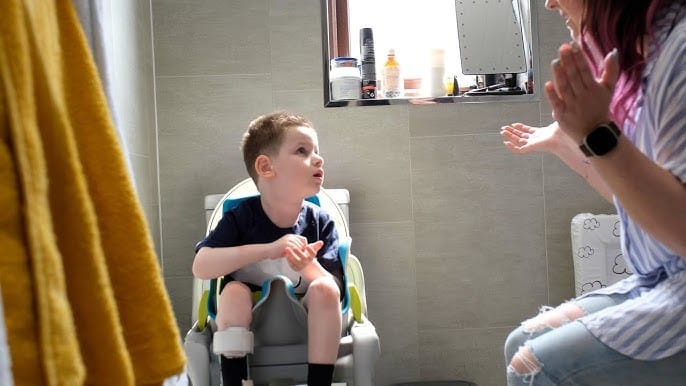Achieving independence in toileting is a significant milestone for any individual, fostering self-esteem and enhancing overall quality of life. For individuals with Cerebral Palsy (CP), this seemingly routine task can present unique challenges due to motor impairments, muscle tone abnormalities, and potential sensory processing differences. However, with a comprehensive and individualized approach that considers these complexities, promoting greater independence in toileting is an achievable goal. This guide delves into the multifaceted aspects of toileting for individuals with CP and explores a range of strategies, adaptive equipment, and therapeutic interventions designed to empower them towards greater autonomy and dignity.
Understanding the Unique Challenges of Toileting with CP
The impact of Cerebral Palsy on motor control and sensory processing can manifest in various ways that affect toileting skills:
- Motor Impairments and Positioning: Difficulties with balance, transfers, and maintaining a stable sitting position on the toilet can hinder independence. Muscle weakness, spasticity, or involuntary movements can make it challenging to manage clothing, initiate and control bowel and bladder movements, and perform necessary hygiene tasks.
- Fine Motor Coordination: Tasks such as manipulating fasteners, using toilet paper, and flushing the toilet require fine motor skills that may be impaired in individuals with CP.
- Communication Barriers: Expressing the need to use the toilet, understanding instructions related to toileting routines, and communicating difficulties can be challenging for individuals with communication impairments often associated with CP.
- Sensory Processing Differences: Some individuals with CP may experience heightened sensitivity to textures, sounds, or smells in the bathroom environment, leading to anxiety or avoidance related to toileting. Conversely, reduced sensation may impact awareness of the need to toilet or the completion of hygiene tasks.
- Associated Medical Conditions: Constipation, urinary incontinence, and other related medical conditions can further complicate toileting and require specific management strategies.
- Developmental Delays: The acquisition of toileting skills may be delayed in individuals with CP, requiring a developmentally appropriate and patient approach.
A Multidisciplinary Approach to Fostering Toileting Independence
Promoting independence in toileting necessitates a collaborative effort involving the individual, their family, caregivers, and a multidisciplinary team, including:
- Occupational Therapists (OTs): OTs play a crucial role in assessing the individual’s physical abilities, recommending adaptive equipment, and teaching strategies for transfers, clothing management, hygiene, and environmental modifications.
- Physical Therapists (PTs): PTs focus on improving gross motor skills, balance, and core strength, which are essential for safe transfers and stable positioning on the toilet.
- Speech-Language Pathologists (SLPs): SLPs can assist with communication strategies to express toileting needs and understand related instructions.
- Medical Professionals (Pediatricians, Urologists, Gastroenterologists): Medical professionals address any underlying medical conditions such as constipation or incontinence.
- Behavioral Therapists: Behavioral strategies can be helpful in establishing routines and addressing any anxiety or avoidance related to toileting.
Strategies and Interventions for Promoting Toileting Independence
A range of strategies and interventions can be implemented to support greater independence in toileting:
Environmental Modifications and Adaptive Equipment
- Toilet Aids: Raised toilet seats, grab bars, commode chairs, and toileting slings can provide support and stability for safe transfers and positioning.
- Adaptive Clothing: Clothing with easy-to-manage fasteners (e.g., Velcro, elastic waistbands) can facilitate independent dressing and undressing.
- Hygiene Aids: Long-handled wiping aids, bidets, and pre-moistened wipes can assist with independent hygiene.
- Sensory Considerations: Adjusting lighting, reducing noise, and using familiar scents can create a more comfortable bathroom environment for individuals with sensory sensitivities.
- Visual Supports: Visual schedules and picture communication boards can provide clear steps for the toileting routine.
Therapeutic Interventions and Skill Development
- Transfer Training: Occupational and physical therapists can teach safe and efficient transfer techniques to and from the toilet.
- Fine Motor Skill Development: Activities to improve hand strength, dexterity, and coordination can enhance the ability to manage clothing and hygiene tasks.
- Establishing Routines: Implementing consistent toileting schedules, often linked to meals and activities, can promote predictability and continence.
- Communication Strategies: Teaching the individual effective ways to communicate their need to toilet, whether through verbalizations, signs, gestures, or augmentative and alternative communication (AAC) devices.
- Continence Training: For individuals with bladder or bowel control challenges, a structured continence training program, guided by medical professionals and therapists, may be beneficial.
- Social Stories: Social stories can help individuals understand the social expectations and steps involved in toileting.
Promoting Motivation and Positive Reinforcement
- Positive Encouragement: Providing praise and positive reinforcement for efforts and successes, no matter how small.
- Visual Progress Charts: Using visual aids to track progress and celebrate achievements.
- Choice and Control: Offering choices related to aspects of the toileting routine (e.g., when to try, which aids to use) can increase motivation and engagement.
The Role of Family and Caregivers
Family and caregivers play a vital role in supporting the individual’s journey towards toileting independence:
- Patience and Understanding: Recognizing that achieving independence may take time and consistent effort.
- Collaboration with the Therapy Team: Actively participating in therapy sessions and implementing recommended strategies at home.
- Creating a Supportive Environment: Ensuring the bathroom is accessible, safe, and comfortable.
- Consistent Reinforcement: Following through with established routines and providing consistent positive reinforcement.
- Advocacy: Advocating for the individual’s needs and access to necessary resources and support.
For further information and resources related to promoting independence in daily living skills for individuals with Cerebral Palsy, we encourage you to explore the comprehensive information available at CP Family Help: Daily Living and Therapy and Support.
Conclusion: Empowering Autonomy and Dignity
Promoting independence in toileting for individuals with Cerebral Palsy is a process that requires patience, understanding, and a tailored approach. By addressing the unique challenges, leveraging assistive technology, implementing effective therapeutic strategies, and fostering a supportive environment, we can empower individuals with CP to achieve greater autonomy, dignity, and an enhanced sense of self-confidence in this essential aspect of daily life.
Frequently Asked Questions: Toileting Independence for Individuals with CP
What are the first steps in promoting toileting independence for an individual with CP?
The first steps involve a comprehensive assessment by an occupational therapist to understand the individual’s current abilities, challenges, and potential. This assessment will inform the development of an individualized plan that may include environmental modifications, adaptive equipment, and therapeutic strategies.
How can adaptive equipment help with toileting independence?
Adaptive equipment such as raised toilet seats, grab bars, and long-handled wiping aids can compensate for motor impairments, providing increased stability, safety, and reach, thereby enabling greater independence in the toileting process.
What role does communication play in achieving toileting independence?
Effective communication is crucial for individuals to express their need to use the toilet, understand instructions related to toileting routines, and communicate any difficulties they may be experiencing. Speech-language pathologists can play a vital role in developing appropriate communication strategies.
How long does it typically take for an individual with CP to achieve toileting independence?
The timeline for achieving toileting independence varies significantly depending on the individual’s level of motor and cognitive function, the consistency of interventions, and the support provided. It’s a process that requires patience and a focus on gradual progress.
What can caregivers do to best support toileting independence at home?
Caregivers can provide consistent support by following the recommendations of the therapy team, establishing predictable routines, creating an accessible and comfortable bathroom environment, offering positive reinforcement, and fostering a patient and encouraging atmosphere.
👉 Fill out our FREE Consultation Form today to speak with a legal expert. Your case could make a difference.




